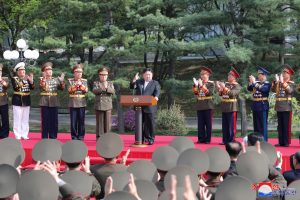Quick Take: North Korea’s “National Defence Industrial Enterprise”

On April 26, North Korean media mentioned a “newly established national defence industrial enterprise under the Second Economy Commission” while reporting that Kim Jong Un, on the previous day, had watched “the evaluation test-fire” of a 240-mm multiple rocket launcher (MRL) shell produced by this enterprise.[1] According to the report, Kim called on the enterprise to “surely carry out the munitions production plan for this year.”
This report has been mainly viewed as drawing attention to the new enterprise’s possible connection to North Korea’s weapons exports and the threat the 240-mm MRL poses to South Korea.
However, we may also consider the new defense industrial enterprise from a domestic economic angle. This new enterprise reinforces the question of whether defense industries are, in fact, playing a leading role in the North Korean economy, despite the heavy state media focus on the civilian economy.
This question is premised on a broader context that includes Kim’s reintroduction of “national defence economic work,” a rarely used term even in his father’s military-first era; his repeated calls on the munitions industry to support defense industries (as opposed to the civilian economy); and regular media commentary on the importance of national defense for stable economic growth.[2] Furthermore, North Korea has consistently used the “war preparations” formulation since early 2023—in line with its hardline US and South Korea policies—and, in recent years, has reined in market-oriented initiatives.[3] A shift to conservative economic policies in North Korea has generally reflected the state’s preference for defense industries over the civilian economy.[4]
It is premature to confirm Pyongyang’s intention of unveiling the new defense industrial enterprise. Furthermore, it is too early to know what role this enterprise will play in the North Korean economy or what it portends for—or how it reflects—Pyongyang’s longer-term economic policy. Yet, it would be remiss to assume this move is only tactical, given its alignment with the state’s broader policy shifts that have taken place since the collapse of the Hanoi Summit in 2019.
- [1]
The Second Economic Commission oversees North Korea’s planning, production, distribution and foreign sales of military products.
- [2]
Rachel Minyoung Lee, “To do or not to do: Pyongyang’s seventh nuclear test calculations,” Bulletin of the Atomic Scientists 80, no. 2 (2024): 87–93, https://doi.org/10.1080/00963402.2024.2314434.
- [3]
Robert Carlin and Rachel Minyoung Lee, “North Korea Makes a Still More Conservative Turn at Party Plenum,” 38 North, January 5, 2023, https://www.38north.org/2023/01/north-korea-makes-a-still-more-conservative-turn-at-party-plenum/; and Rachel Minyoung Lee, “War in Ukraine: Implications for North Korea,” 38 North, February 22, 2024, https://www.38north.org/2024/02/war-in-ukraine-implications-for-north-korea/.
- [4]
Robert Carlin and Rachel Minyoung Lee, “Understanding Kim Jong Un’s Economic Policymaking: Defense Versus Civilian Spending,” 38 North, September 22, 2021, https://www.38north.org/2021/09/understanding-kim-jong-uns-economic-policymaking-defense-versus-civilian-spending/.
